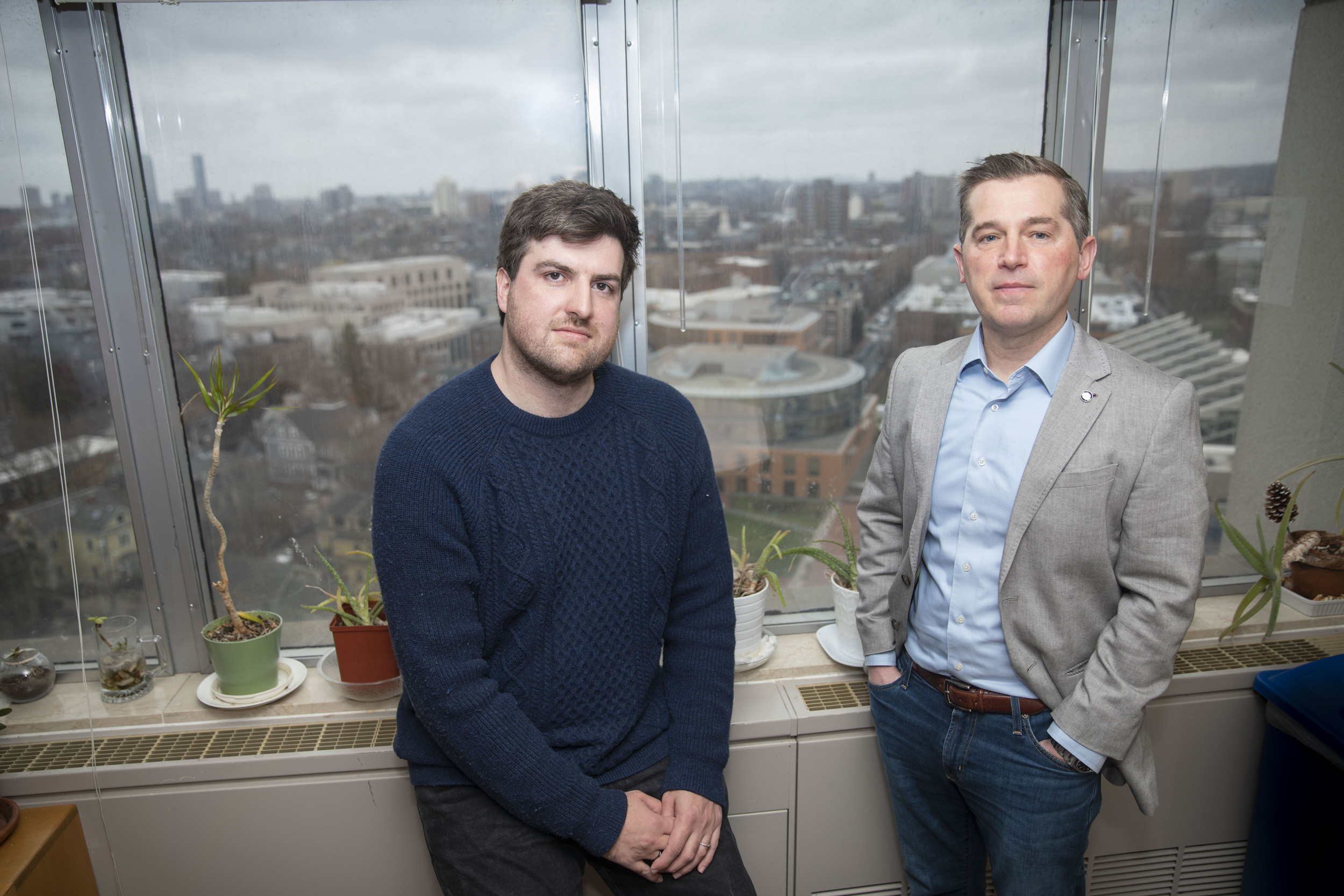
Using a smartphone app, Daniel Coppersmith (left) and Matthew Nock were able to capture suicidal thinking as it occurred.
Kris Snibbe/Harvard Staff Photographer
Tracking rapidly changing patterns of suicidal thought
Smartphones enabled researchers to capture shifts multiple times a day, gathering data that could help guide more effective prevention
In a new study, Harvard researchers took a granular approach to measuring the duration and frequency of suicidal thinking. With the help of a smartphone app, they were able to monitor participants multiple times a day over several weeks. These assessments revealed that suicidal thinking changes rapidly — with far shorter timescales than previously thought. And they offered a firmer sense of when suicidal desire is most predictive of future intent.
According to lead author Daniel Coppersmith, a Ph.D. student who works in a lab with the influential suicide researcher Matthew Nock, academic interest in suicide has increased in recent decades. But most of that research has focused on quantifying deaths or identifying risk. Few have sought to understand the fundamental contours of self-injurious thinking and behavior, information that can help better guide more effective prevention.
“A foundational aspect of other areas of science is observing natural phenomena as they unfold in the wild,” Coppersmith said. “Because we haven’t necessarily done that with suicide, we don’t have answers to basic questions like: How often do suicidal thoughts occur? How long do they last?”
The results were published this week in the Proceedings of the National Academy of Sciences of the United States of America (PNAS).
With the new study, Coppersmith, Nock, and their co-authors wanted to capture suicidal thinking as it occurred. Over 42 days, 105 adults with histories of suicidal thought received high-frequency pop-ups via the app with questions about their thoughts and feelings. One prompt asked about their level of suicidal desire at that very moment. Another concerned their current state of suicidal intent. Answers could be given on a scale from zero to 10, with 10 signaling a “very strong” desire or intent to kill oneself.
Crunching the data yielded several fresh insights. First, suicidal thinking tends toward brevity. Less frequent assessments put the average duration of elevated suicidal desire at 9½ hours. High-frequency testing put that average at 1.4 hours. “If we didn’t have this higher-frequency sample of data, we might infer that these types of thoughts last much longer,” Coppersmith said.
High-frequency sampling also confirmed previous studies that found suicidal thinking comes and goes. “Even among people who were recently suicidal, or have a history of suicidal behavior, they’re not thinking of suicide most of the time,” Coppersmith said. “Zero” was the most common answer given when ranking suicidal desire and suicidal intent.
Finally, different types of suicidal thinking operate according to different timescales. Current suicidal desire tends to predict future suicidal desire for about 20 hours, whereas suicidal intent is less common and can be predicted in timescales of only one to three hours. “We also have a better understanding of how these different constructs interact,” Coppersmith noted. “We were able to zoom in on the window in which desire is most predictive of future intent, which also seems to last around two to three hours.”
Nock, the Edgar Pierce Professor of Psychology and chair of Harvard’s Psychology Department, led a similar study 15 years ago. Back then Nock and his team relied on PalmPilots, which limited polling to a few times per day. Still, end-of-the-day self-assessments revealed that suicidal thinking had passed in an hour or less for the majority of study volunteers. “People were describing these short intervals,” Coppersmith said, “but [the researchers] weren’t collecting data within those time windows.”
Sometimes volunteers in the new study received a ping every few hours. At other times, an hourlong burst brought alerts every 10 minutes. Nock, who earned a MacArthur award in 2011 for his work in suicide research and prevention, likened this approach to technological advances in microscopes, which allow scientists to zoom in ever closer on their subjects.
The researchers emphasized that it’s safe to ask study participants about suicide, with no increased risk according to multiple meta-analyses. Throughout the process, Coppersmith added, volunteers were reminded via the app about the 988 Suicide & Crisis Lifeline and other resources.
While the findings are illuminating, suggesting that suicidal risk appears and recedes over extremely short periods of time, Coppersmith cautioned that more research is needed before concrete prescriptions can be offered. “But if we have a better understanding of the timescale,” he said, “we may eventually have a better understanding of when to deploy interventions.”





